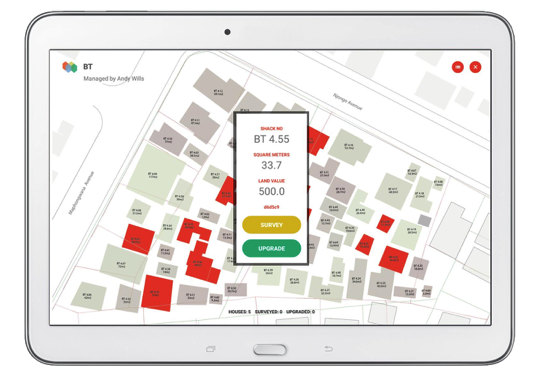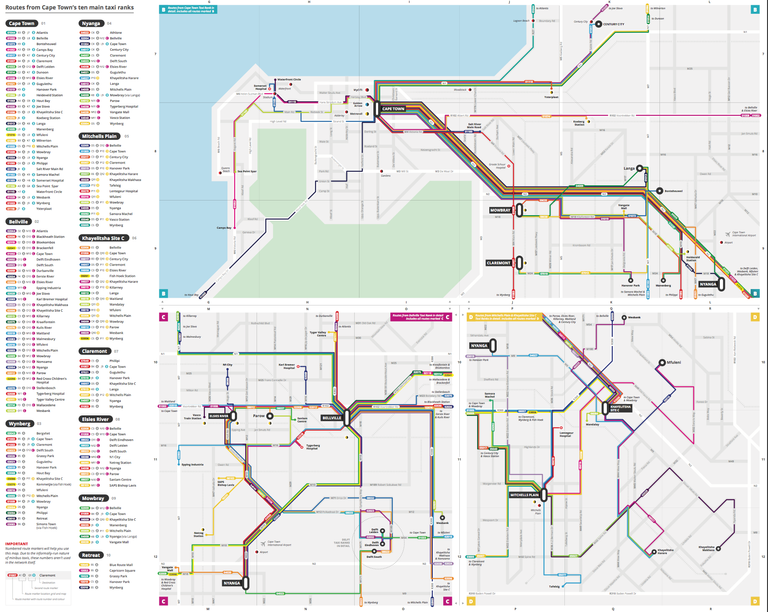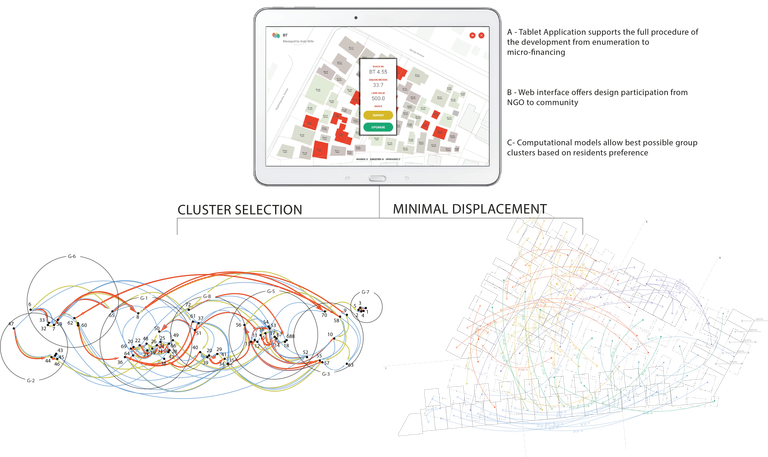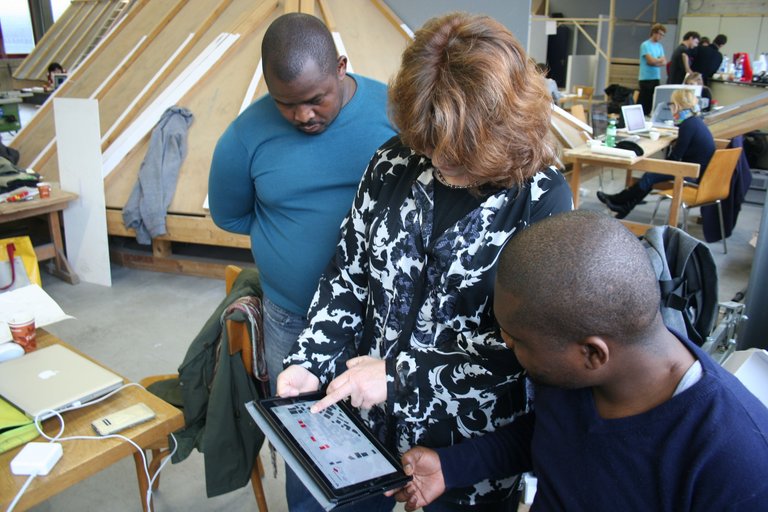Last week we presented you with the idea of incremental to compliance- a strategy that sets out a clear pathway to developing formal housing units through the agency of the community whilst providing the community with dignified housing conditions. The right to housing is embedded in the South African constitution however the static form of frameworks and policies has resulted in a slow realization of these visions.

- Beta version of the land-readjustment app
How do we make these visions sustainable? How do the goals captured in static documentation, policies and frameworks keep up with the fast pace of changing communities and their needs? Well, we have found that the answer lies in digital planning tools. The digital tools aim to provide strategic decision-making support and user input synthesis for urban transformations.
More so, we couldn’t think of a better platform to discuss the relationship between social impact and technology! We’re excited to hear what your thoughts are on this post.
Emerging practices in social organisation and digital processes have uncovered a potential to address the failures of traditional planning frameworks to address the complexity and dynamic of both contemporary urban environments and citizen agency. Both these developments are geared at decentralisation, and concomitantly offer radical alternatives to addressing both the increasing complexity of urban planning and the emergent demands for citizen participation in the digitalized societies (castells 2010).
The EMPOWER methodologies have essentially been digitized to allow for scalability and replicability. This allows future design decisions to be constantly informed by the context, which is kinetic. The tool is live in its digital form, and can therefore be used for what we call adaptive re-use. What is adaptive re-use you may ask? In this case, the tool is able to tailor itself to new contexts by receiving specific information from the local user, which is adapted to simulate outcomes to meet the needs of the context at hand. The tools that have proven to be effective can therefore quicken the process of development in areas that require similar attention. Why re-invent the wheel? We have found that a few other initiatives are also beginning to hone into the fourth industrial revolution as an opportunity to make social impact. For example, Where is My Transport – pluri-disciplinary app developers have recently created an interface that maps the kinetic minibus system in Cape Town and many other African cities. The minibus system is a completely informal sector, which provides the vast majority of South African citizens with transport, and was born in response to a clear public transport infrastructure deficit and economic assessable. WhereIsMyTransport collaborated with the SDI South African Alliance to combine cutting edge tech with local knowledge to similarly empower slum dwellers and communities. This allows residents to plan their mobility routes more effectively in providing access to previously a previously unmapped and constantly changing transport network. This is one example of many initiators capitalizing on digital planning tools as a means of empowerment and sustainable development in the rapid data exchange world that we live in today.

- Image showing map routes produced by WhereIsMyTransport of informal minibus system in Cape Town
These informal settlements have growing access to technological gadgets such as smartphones, making digital tools increasingly accessible. With the ever-changing unrecorded conditions of informal negotiations and physical change- allowing people to take their own agency and participate in providing this content in an effective way of capturing the real conditions of informality. Coupled with the surge of interest from the millennial youth in using and understanding emerging technologies, digital planning tools can be used by the people in order to work for the people.
Digital Tools and Participation
The possibilities that have emerged from the advancement of technology have broadened the capacity of citizens to participate in shaping their built environments. In a pre-digital era and common in informality today, participation was/is typically incentive-based to ensure engagement. However, there is a palpable need for organizations to provide means for individuals to act upon their own agency and so what better way than to capitalize on the ever expanding fast growing data world of the 4th industrial revolution.
- Image showing digital tools being used live at Glarus workshop with collaborators and community
So how can new digital tools act as an interface between citizen participation and urban planning frameworks?
The digital tool being developed by the EMPOWER project offers planners, the community and city decision makers a powerful interface to synthesis multi-user preferences that responds to the socio spatial dynamics of insitu urban development. The existing beta tool was conceived with our colleagues at Information Architecture ETHZ and is developed from constant feedback and research gathered from the multiple collaborators and community members in the project. The tool is intended to support transparent and fluid workflow between landowners, municipal governments, upgrade facilitators and the community development committee. The tool therefore provides a touchstone between the various actors that hold a stake in the urban environment.
The digital tool assists in recording and aiding the processes of participation. It provides an interface that guarantees transparency through the recording of workshops, task team assistance, survey and enumeration data, micro-finance payments and individual user upgrade preferences.

- Image showing translation of physical participation and planning processes into digital form for future use
What is the tool exactly?
The tools offer a public interface and computational procedures for urban layout scenario generations that respond to contextual planning and community preference inputs. This is achieved in the form of 1) upgrade tablet application and 2) a coded plug-in scripts for open-source planning software.
1)upgrade tablet application
The customized tablet application is a unique community facilitator tool for on-site recording, site and cost analysis, prospective design presentation and community data inputs. The tool takes the form of a tablet application designed to support the facilitation, documentation and contract requirements of the urban upgrade including micro-finance and right-to-stay contracts. The tablet application records individual household data, resident upgrade preferences – including neighbour selection, affordability assessments and is supported by an integrated camera feature in order to visually record the existing residents’ unit. After urban simulations are achieved through the computational tool and loaded to the app, the facilitator can present the updated settlement layout scenarios to receive resident input and dynamically adjust the layout according to new preferences and affordability assessments. Residents can opt to increase the size and features of their upgraded unit and have it recalculate micro-finance contribution. If approved, the agreement is updated via the touchscreen signing function. The application is completed once all residents have locked in their final inputs. The data is then used to inform the final urban design layouts and micro-finance payment schedules. Once the micro-finance contracts are closed, the project can be archived, and a new project launched using the same methodology.
2) A coded plug-in scripts for open-source planning software.
The digital tool intends to be a standalone planning instrument containing 4th dimension simulations, and an active participation platform. The digital tool has predetermined parameters in which users can respond to. For example, the land readjustment allows 40% of the previous occupied footprint to be reinvested as urban spatial assets in the form of firebreaks, safe playing environments, routes of access for emergency vehicles and bio-filters for managing the water run-off. These parameters ensure that the socially unique input from the community user is spatially viable from an infrastructure and built environment pragmatic point of view. The tool is also susceptible to change; in that the urban blocking strategies, are informed by the users and these are fundamentally social parameters for developing possible scenarios. We refer to this as preferential city making.
- Video showing preferential city making of digital tool | U-TT
For the moment, the digital tools include a plug-in application to rhino cad software that among other functionalities:
- Automatically generates layout scenarios based on user defined parameters (preferred existing street networks and public spaces, topography, new building dimensions, new plot sizes and street widths, geometric constraints from municipal planning frameworks, building orientation, proximity to existing infrastructure)
- Automatically regenerates layouts in response to adjustments to user defined parameters
- Automatically groups buildings according to community neighbour preferences
- Generates real-time data projections with each generated layout (public-private land split, potential number of units, projected: building costs, infrastructure investment, micro-finance contributions, street lengths,)
- Offers visual analysis of layouts with the aid of heat maps according to user defined themes (security visibility, street unit accessibility, fire risk, proximity to infrastructure)
In addition, the generation of the layout scenarios can be sent to a custom designed online interface that allows collaborators to offer feedback on particular layouts in a 3D digital environment. The interface also offers project managers access to unit specific data by clicking on individual units in the layout. This can be viewed in the short film:
Sustainability: Replicability and Scalability
The digital planning tools are developed in various forms for replicability and scalability. Namely, as an upgrade tablet application, a computational analysis & planning software as well as an online interface. The tool emphasizes sustainability through the transfer of knowledge for future projects giving practitioners and communities effective and existing methods that can be adapted to their particular contexts for productive development. A few posts back, we mentioned adaptive research and digitial planning tools are the means to sustaining research for future use. The project acknowledges that current research remains static in documentation but unexplored in digital form; and through digital planning tools live information becomes the foundation of relevant research. The tools are constantly being developed, and if you feel that this interests you and you have the skills to creatively advance them, please do let us know! The collaborator network is continues to grow.
We’ll soon be talking about the micro-financing system that the EMPOWER project has implemented to demonstrate that marginalised communities can indeed contribute to the financing of urban development. The opportunity that technology could play in this space is immense. Perhaps the micro-financing system could be developed into a economic model that will take on the form of a new currency? The blockchain is not an unfamiliar system of exchange to the African context. The fact that the blockchain is a decentralized and transparent technology opens up the door to fighting corruption, which currently runs rife in many African political and economic systems. As mentioned by The Financial Gazette, “in view of Zimbabwe’s financial inclusion strategy, having crypto-currencies is one of the available options that can provide access to finance among the country’s poorest and marginalized citizens.” Ghana and South Africa have an increasing amount of blockchain companies. In an unbanked sector, African countries have a huge opportunity to specialize their economies in an emancipatory fashion that is no longer reliant on the traditional western cannon way of thinking about banking and exchange.

What a fascinating resource to engage local stakeholders and also a mechanism that gives them the power to curate the growth of their own community.
Looking forward to learning more about the micro-financing strategies that you have integrated into this open-source planning approach. Thanks as always for these thoughtful and empowering articles!